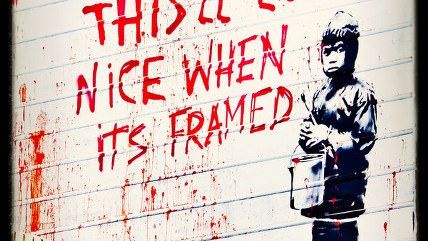In Defense Of Banksy and Guerrilla Street Art
It's more than an act of crime or commerce

To be a brand name in guerrilla street art is to be in exclusive company. And no one has built a bigger brand imposing his stencils, spray paintings, and sculptures on the world than Banksy. His latest installation, a scattershot, month-long spree of works called "Better Out Than In," proved that to anyone who pays attention to New York City. Every day, across the five boroughs, the secretive artist debuted a fresh piece in a new location, spawning excited Instagrams, an interactive street map, and, yes, grumbling critique: not just from nannyesque Bloombergians, but the kinds of property rights advocates who sometimes cross swords with the Mayor. That is art Banksy style: sticking it to the man, and maybe to you too.
Apart or together, his compositions aren't hard to interpret—meditations on the hypocrisies and opportunities of city life. But inseparable from the art is the nuanced question of how we, the audience, can choose to respond. Here Banksy offers little guidance. He seems fully content to let critics decry him as a criminal, or worse, as a crass commercialist.
From a certain angle, however, we don't get much access to the Banksy phenomenon by confidently consigning what he creates to the realms of rights violations or market valuations. Just as we hesitate to separate ourselves from his art, we might not abstract it away from the public and private space it appears in.
If we don't separate the art from its space, we heighten our awareness of how a few impressive features define his ambiguous installation. First, Banksy really has taken street art to another level. It's not just that he's tossed some sculpture into the mix of sprayed-on illustrations. It's that he's gone beyond the standard of a focused, coherent body of work that the best street artists refine. Banksy has actually curated a collection of artworks, not just in real time but in real space. He's become his own museum.
But a museum doesn't have to be identical to the building it's in, as the Getty, for instance, arguably is. October's "Banksy Museum" is housed in a "building" called The City of New York. Artists have analogized Gotham to a (Gothic!) cathedral for years. You've probably heard the band M83's hit lyric, "the city is my church," but have you done a Google image search on that line? It's a metaphor of tremendous power, especially to the not particularly religious. With "Better Out Than In," Banksy gives us a strange feeling because pushing his art onto the street gives us a more cathedral-like experience of society.
What's that experience like? Well, Christians characteristically imagine the church as the place where you're particularly suited to recognize the presence of grace. There, the never-predictable, always possible gifts of God can suddenly pop into view and into your life. For secular-minded people, that sometimes seems like a trick of the mind, an act of obscurantism or superstition. But we pretty much all can remember a time when a place, a moment, or a person brought on roughly the same situation: there we were, going about our own business, when something, or someone, transformed us. Maybe for an instant? Maybe for the rest of our lives? Either way, without asking for anything in return.
That's grace. And that's the way Banksy operates.
Yes, he's imposing his interests and seeking his pleasures at the figurative, or sometimes literal, expense of others. But these costs are typically so minimal that they place us in a gray area of reasonable forbearance. Someone hangs a picture on the outside of your office. Someone stands on your lawn and tells you a skilled tale about a powerful dream they had. What do you do with these strangers? Sue them? Fine them? Probably not.
In that way, Banksy's unauthorized art invites us to think anew about the place of street art in our lives. Anyone's street art can be something wonderful for us, if we want it to be. And at an adequate level of skill and vision, it can renew Banksy's own offer to reconsider our sense of public and private space.
Particularly in New York (says this Los Angeleno), both public and private space can be lifeless and interstitial—either "empty" spaces or small, unofficial reservoirs for junk or dirt, posters or ads. Street art can disrupt both kinds of lifelessness. Private owners and public officials can stomp on that activity, returning their system to stasis. That's their prerogative. But they're under no real compulsion to do so, beyond the fear that "inaction" will make them lose control of the space they claim as their own.
We might hesitate to bring the bootheel down on Banksy because he's not just disrupting our space—he's transforming its character. But even if we don't really dig his work, and wish it wasn't there, surely we can grasp that his installations can only be as they are in a context of rigorously controlled city space!
That's right. Although all street art might be an act of grace, the uniqueness of Banksy's effect on New York strongly suggests that the grace notes of street art show forth for us when they are relatively rare, surprising, and subtle, the products of deep reflection and hard work.
It might strike you that this is a standpoint that's narrow and generous in somewhat equal measure. It's a combination that acts of grace seem especially apt to deliver. They deliver us—from the burden of opposing or embracing a thing or a fellow human with all our conviction. Just as grace comes free, it leaves us a little more free.
Religion or no, if we can come to see grace at work in our street art, perhaps we can also come to see it at work in one another.


Show Comments (164)